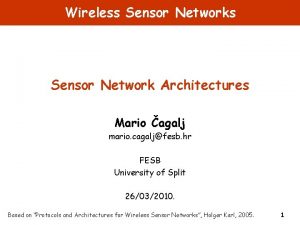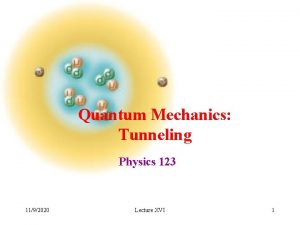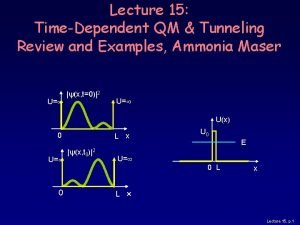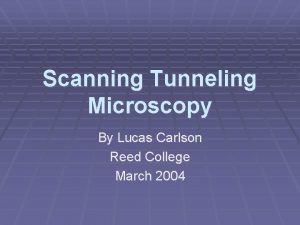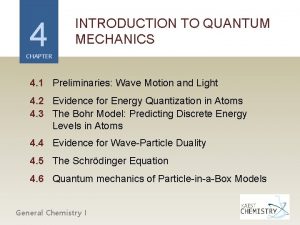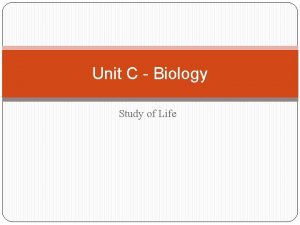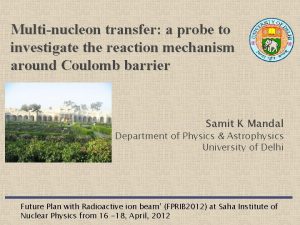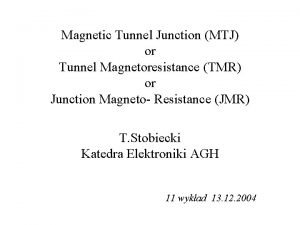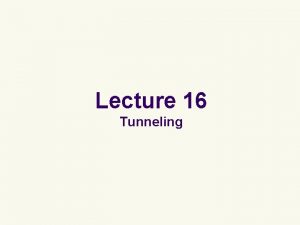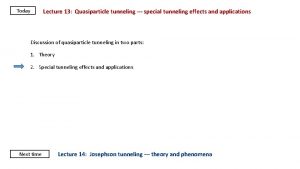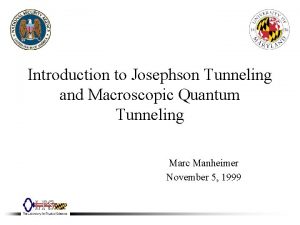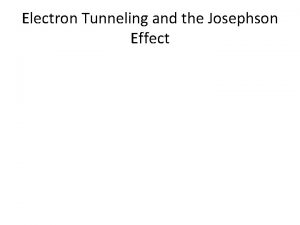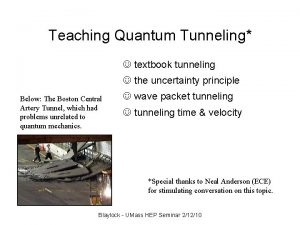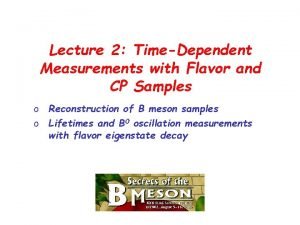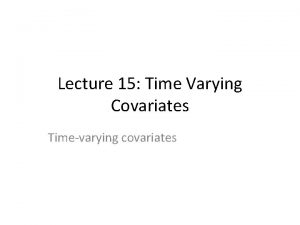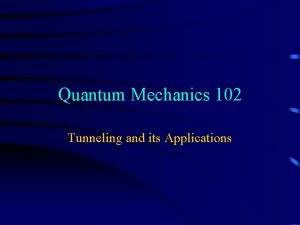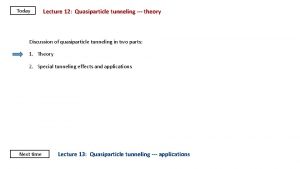Lecture 15 TimeDependent QM Tunneling Review and Examples


























- Slides: 26

Lecture 15: Time-Dependent QM & Tunneling Review and Examples, Ammonia Maser U= | (x, t=0)|2 U= U(x) 0 U= 0 L x | (x, t 0)|2 U= x U 0 E 0 L x Lecture 15, p. 1

Measurements of Energy What happens when we measure the energy of a particle whose wave function is a superposition of more than one energy state? If the wave function is in an energy eigenstate (E 1, say), then we know with certainty that we will obtain E 1 (unless the apparatus is broken). If the wave function is a superposition ( = a 1+b 2) of energies E 1 and E 2, then we aren’t certain what the result will be. However: We know with certainty that we will only obtain E 1 or E 2 !! To be specific, we will never obtain (E 1+E 2)/2, or any other value. What about a and b? |a|2 and |b|2 are the probabilities of obtaining E 1 and E 2, respectively. That’s why we normalize the wave function to make |a|2 + |b|2 =1. Lecture 13, p 2

Example An electron in an infinite square well of width L = 0. 5 nm is (at t=0) described by the following wave function: U= |Y(x, 0)|2 0 U= L |Y(x, t)|2 x U= Determine the time it takes for the particle to move to the right side of the well. 0 L x Lecture 15, p. 3

Solution An electron in an infinite square well of width L = 0. 5 nm is (at t=0) described by the following wave function: U= |Y(x, 0)|2 0 U= L |Y(x, t)|2 x U= Determine the time it takes for the particle to move to the right side of the well. 0 L x T = 1/f , where f = (E 2 -E 1)/h Half a period. Lecture 15, p. 4

ACT 1 An electron in an infinite square well of width L = 0. 5 nm is (at t=0) described by the following wave function: U= |Y(x, 0)|2 0 1) Suppose we measure the energy. What results might we obtain? a) E 1 b) E 2 c) E 3 d) Any result between E 1 and E 2 U= L |Y(x, t)|2 0 x U= L x 2) a) b) c) How do the probabilities of the various results depend on time? They oscillate with f = (E 2 -E 1)/h They vary in an unpredictable manner. They alternate between E 1 and E 2. (i. e. , it’s always either E 1 or E 2). d) They don’t vary with time. Lecture 15, p. 5

Solution An electron in an infinite square well of width L = 0. 5 nm is (at t=0) described by the following wave function: U= |Y(x, 0)|2 0 1) Suppose we measure the energy. U= What results might we obtain? a) E 1 b) E 2 c) E 3 d) Any result between E 1 and E 2 We will only obtain results that correspond to the terms 0 appearing in Y. Therefore, only E 1 and E 2 are possible. U= L |Y(x, t)|2 x U= L x 2) a) b) c) How do the probabilities of the various results depend on time? They oscillate with f = (E 2 -E 1)/h They vary in an unpredictable manner. They alternate between E 1 and E 2. (i. e. , it’s always either E 1 or E 2). d) They don’t vary with time. Lecture 15, p. 6

Solution An electron in an infinite square well of width L = 0. 5 nm is (at t=0) described by the following wave function: U= |Y(x, 0)|2 0 1) Suppose we measure the energy. U= What results might we obtain? a) E 1 b) E 2 c) E 3 d) Any result between E 1 and E 2 We will only obtain results that correspond to the terms 0 appearing in Y. Therefore, only E 1 and E 2 are possible. U= L |Y(x, t)|2 x U= L x 2) a) b) c) How do the probabilities of the various results depend on time? They oscillate with f = (E 2 -E 1)/h The probabilities depend on the They vary in an unpredictable manner. coefficients, not on the various Y terms They alternate between E 1 and E 2. themselves. Because the coefficients (i. e. , it’s always either E 1 or E 2). are simply numbers ( ), there is no d) They don’t vary with time dependence. Lecture 15, p. 7

Tunneling Through a Barrier In many situations, the barrier width L is much larger than the ‘decay length’ 1/K of the penetrating wave (KL >> 1). In this case B 1 0 (why? ), and the result resembles the infinite barrier. The tunneling coefficient simplifies: U(x) U 0 E 0 L x This is nearly the same result as in the “leaky particle” example! Except for G: We will often ignore G. (We’ll tell you when to do this. ) The important result is e-2 KL. Lecture 15, p. 8

ACT 2 What effect does a barrier have on probability? Suppose T = 0. 05. What happens to the other 95% of the probability? a. It’s absorbed by the barrier. b. It’s reflected by the barrier. c. The particle “bounces around” for a while, then escapes. Lecture 15, p. 9

Solution What effect does a barrier have on probability? Suppose T = 0. 05. What happens to the other 95% of the probability? a. It’s absorbed by the barrier. b. It’s reflected by the barrier. c. The particle “bounces around” for a while, then escapes. Absorbing probability would mean that the particles disappear. We are considering processes on which this can’t happen. The number of electrons remains constant. Escaping after a delay would contribute to T. Lecture 15, p. 10

Tunneling Exercise Suppose an electron of KE = 0. 1 e. V approaches a barrier. For what barrier height will it have a 50% chance of penetrating 1 nm into the forbidden region? What about 1 mm? Here you can assume that the G term is not important. Lecture 15, p. 11

Solution Suppose an electron of KE = 0. 1 e. V approaches a barrier. For what barrier height will it have a 50% chance of penetrating 1 nm into the forbidden region? What about 1 mm? Here you can assume that the G term is not important. Solution: In the forbidden region: K = (2 m(U-E)) / e-2 KL = ½ U is the unknown barrier height and E = 0. 1 e. V. The 2 in e-2 KL results from probability being | |2. Note that all that really matters is U-E. L = 1 nm: U = E + ( ln(2)/2 L)2 / 2 m = 0. 1 e. V + 7. 4 10 -22 J = 0. 105 e. V L = 1 mm: = 0. 1 e. V + 7. 4 10 -28 J = 0. 100000005 e. V Penetration a significant distance isn’t possible unless E ~ U. The particle is at the top of the barrier. Lecture 15, p. 12

Example: Aluminum wire Why household electrical wire is not aluminum: Aluminum is cheap and a good conductor. However, aluminum tends to form an oxide surface layer (Al 2 O 3) which can be as much as several nanometers thick. This layer could cause a problem in making electrical contacts, since it presents a barrier roughly 10 e. V high to the flow of electrons in and out of the Al. U 0 Al 2 O 3 E Al wire Other conductor 0 L Your requirement is that your transmission coefficient across any contact must be T > 10 -10, or else the resistance will be too high for the high currents you’re using, causing a fire risk. Should you use aluminum wiring or not? (You can neglect G here. ) Lecture 15, p. 13

Solution Why household electrical wire is not aluminum: Aluminum is cheap and a good conductor. However, aluminum tends to form an oxide surface layer (Al 2 O 3) which can be as much as several nanometers thick. This layer could cause a problem in making electrical contacts, since it presents a barrier roughly 10 e. V high to the flow of electrons in and out of the Al. U 0 Al 2 O 3 E Al wire Other conductor 0 L Your requirement is that your transmission coefficient across any contact must be T > 10 -10, or else the resistance will be too high for the high currents you’re using, causing a fire risk. Should you use aluminum wiring or not? (You can neglect G here. ) Compute the maximum L: Oxide is thicker than this, so go with copper! Al wiring in houses is illegal for this reason. Lecture 15, p. 14

Electron Approaching a Step Suppose an electron with energy E approaches a step, effectively an infinitely wide barrier of height 2 E. (I picked this ratio to simplify the math. ) U 0 = 2 E E What does the wave function look like, and what is happening? Lecture 15, p. 15

Solution Suppose an electron with energy E approaches an infinitely wide barrier of height 2 E. (I picked this ratio to simplify the math. ) U 0 = 2 E E What does the wave function look like, and what is happening? Here’s the solution: sin(3 p/4) = 1/ 2 0 K = k, because U 0 -E = E. The constants 2 and 3 p/4 come from the boundary conditions. -4 l -3 l -2 l -l l e-2 p = 0. 002 What is this graph telling us? Lecture 15, p. 16

Solution For legibility, I’m ignoring the 3 p/4 phase shift. 0 Sin(kx) is a standing wave. It has nodes every l/2. So, what do I mean when I say that the electron approaches the barrier? -4 l -3 l -2 l -l l Remember two things: The wave oscillates: e-iwt. We can write: sin(kx) = (eikx - e-ikx) / (2 i) Thus, this standing wave is actually a superposition of two traveling waves: ei(kx-wt) and ei(-kx-wt). The incoming wave, traveling to the right. The reflected wave, traveling to the left. The wave is entirely reflected. None is absorbed by the barrier. It penetrates a short distance, but then bounces out. Lecture 15, p. 17

Double Well Oscillation Consider the double well shown. The two energy levels of interest are E 1 = 1. 123 e. V and E 2 = 1. 124 e. V. At t = 0, Y is in a superposition that maximizes its probability on the left side. E 2 E 1 1) At what time will the probability be maximum on the right side? 2) If the barrier is made wider, will the time become larger or smaller? What about E 2 - E 1? Lecture 15, p. 18

Solution Consider the double well shown. The two energy levels of interest are E 1 = 1. 123 e. V and E 2 = 1. 124 e. V. At t = 0, Y is in a superposition that maximizes its probability on the left side. E 2 E 1 1) At what time will the probability be maximum on the right side? The period of oscillation is: T = h/(E 2 -E 1) = 4. 135 10 -15 e. V. s / 0. 001 e. V = 4. 1 10 -12 s. We want a half period: T/2 = 2. 1 10 -12 s = 2. 1 ps. 2) If the barrier is made wider, will the time become larger or smaller? What about E 2 -E 1? Lecture 15, p. 19

Solution Consider the double well shown. The two energy levels of interest are E 1 = 1. 123 e. V and E 2 = 1. 124 e. V. At t = 0, Y is in a superposition that maximizes its probability on the left side. E 2 E 1 1) At what time will the probability be maximum on the right side? The period of oscillation is: T = h/(E 2 -E 1) = 4. 135 10 -15 e. V. s / 0. 001 e. V = 4. 1 10 -12 s. We want a half period: T/2 = 2. 1 10 -12 s = 2. 1 ps. 2) If the barrier is made wider, will the time become larger or smaller? What about E 2 -E 1? A wider barrier will have a smaller tunneling rate, so T/2 will increase. This implies that E 2 -E 1 becomes smaller. We’ll see (week 7) that this effect is important in chemical bonding. Lecture 15, p. 20

Example: The Ammonia Molecule This example will bring together several things you’ve learned so far. Consider the ammonia (NH 3) molecule: H N Plane of hydrogen atoms. The N atom in the ammonia molecule (NH 3) can has two equilibrium positions: above or below the plane of the H atoms, as shown. If we graph the potential as the N atom moves along the line joining these positions, we get: NH 3 Model U(x) x The nitrogen atom can tunnel between these two equivalent positions. Lecture 15, p. 21

Example: The Ammonia Molecule (2) These are not square wells, but the idea is the same. The lowest energy state is the symmetric superposition of the two single-well wave functions. The antisymmetric state has slightly higher energy: DE = 1. 8 10 -4 e. V. Edge view of the hydrogen plane (x) Difference U(x) E 2 E 1 0 x Sum Lecture 15, p. 22

Example: The Ammonia Molecule (3) Given the energy difference between the ground and first excited states, E 2 - E 1 = 1. 8 x 10 -4 e. V, estimate how long it takes for the N atom to “tunnel” from one side of the NH 3 molecule to the other? U(x) E 2 E 1 0 x Lecture 15, p. 23

Example: The Ammonia Molecule (3) Given the energy difference between the ground and first excited states, E 2 - E 1 = 1. 8 x 10 -4 e. V, estimate how long it takes for the N atom to “tunnel” from one side of the NH 3 molecule to the other? U(x) E 2 E 1 0 x This takes a half the oscillation period, T = h/(E 2 -E 1): Lecture 15, p. 24

The Ammonia Maser Stimulated emission of radiation between these two lowest energy states of ammonia (DE = 1. 8 x 10 -4 e. V) was used to create the ammonia maser, by C. Townes in 1954 (for which he won the Nobel prize in 1964). What wavelength of radiation does the maser emit? U(x) E 2 E 1 0 x The maser was the precursor to the laser. The physics is the same (more later). Lecture 15, p. 25

The Ammonia Maser Stimulated emission of radiation between these two lowest energy states of ammonia (DE = 1. 8 x 10 -4 e. V) was used to create the ammonia maser, by C. Townes in 1954 (for which he won the Nobel prize in 1964). What wavelength of radiation does the maser emit? U(x) E 2 E 1 x 0 Solution: By energy conservation, E 2 -E 1 = Ephoton = hc/l l = hc/(E 2 -E 1) = 1240 e. V. nm/1. 8 x 10 -4 e. V = 6. 88 106 nm = 6. 88 mm microwaves The maser was the precursor to the laser. The physics is the same (more later). Lecture 15, p. 26
 Wsn tunneling
Wsn tunneling Quantum tunneling
Quantum tunneling Tunneling coefficient
Tunneling coefficient Define scanning tunneling microscope
Define scanning tunneling microscope Quick bread ingredients functions
Quick bread ingredients functions Tunneling
Tunneling Scanning tunneling microscope history
Scanning tunneling microscope history Vpn tunneling
Vpn tunneling Dns tunneling android
Dns tunneling android Scanning tunneling microscope
Scanning tunneling microscope Leslie stephen virginia woolf
Leslie stephen virginia woolf Scanning tunneling microscope
Scanning tunneling microscope Tunneling effect
Tunneling effect Azure load balancer
Azure load balancer Mtj junction
Mtj junction 01:640:244 lecture notes - lecture 15: plat, idah, farad
01:640:244 lecture notes - lecture 15: plat, idah, farad Chapter review motion part a vocabulary review answer key
Chapter review motion part a vocabulary review answer key Writ of certiorari ap gov example
Writ of certiorari ap gov example Nader amin-salehi
Nader amin-salehi What is inclusion and exclusion
What is inclusion and exclusion Narrative review vs systematic review
Narrative review vs systematic review Pr strengths and weaknesses
Pr strengths and weaknesses Electricity and magnetism lecture notes
Electricity and magnetism lecture notes Power system dynamics and stability lecture notes
Power system dynamics and stability lecture notes Microbial physiology notes
Microbial physiology notes Limits fits and tolerances lecture notes
Limits fits and tolerances lecture notes Cloud computing lecture
Cloud computing lecture
